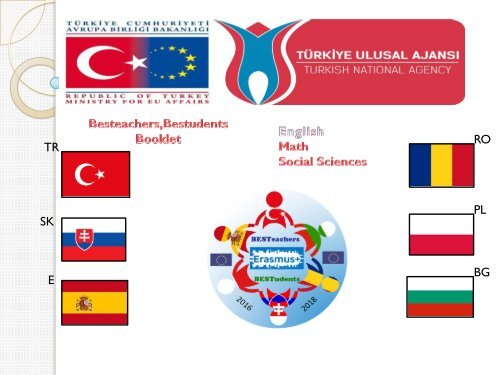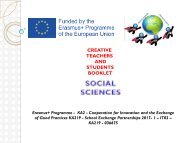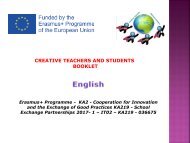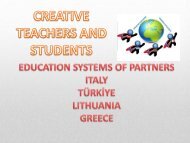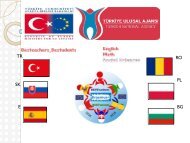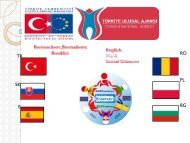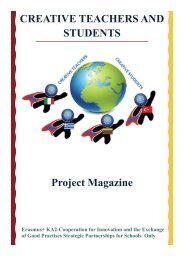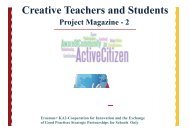You also want an ePaper? Increase the reach of your titles
YUMPU automatically turns print PDFs into web optimized ePapers that Google loves.
TR<br />
RO<br />
SK<br />
PL<br />
E<br />
BG
Language teaching methodologies<br />
Listed below are brief summaries of some of the more<br />
popular second language teaching methods of the last<br />
half century.<br />
The Direct Method<br />
In this method the teaching is done entirely in the target language. The<br />
learner is not allowed to use his or her mother tongue. Grammar rules<br />
are avoided and there is emphasis on good pronunciation.
Grammar-translation<br />
Learning is largely by translation to and from the target language.<br />
Grammar rules are to be memorized and long lists of vocabulary learned<br />
by heart. There is little or no emphasis placed on developing oral ability.<br />
Audio-lingual<br />
The theory behind this method is that learning a language means<br />
acquiring habits. There is much practice of dialogues of every situations.<br />
New language is first heard and extensively drilled before being seen in<br />
its written form.
The structural approach<br />
This method sees language as a complex of grammatical rules which are<br />
to be learned one at a time in a set order. So for example the verb "to<br />
be" is introduced and practised before the present continuous tense<br />
which uses "to be" as an auxiliary.<br />
Suggestopedia<br />
The theory underlying this method is that a language can be acquired<br />
only when the learner is receptive and has no mental blocks. By various<br />
methods it is suggested to the student that the language is easy - and in<br />
this way the mental blocks to learning are removed.
Total Physical Response (TPR)<br />
TPR works by having the learner respond to simple commands such as<br />
"Stand up", "Close your book", "Go to the window and open it." The<br />
method stresses the importance of aural comprehension.<br />
Communicative language teaching (CLT)<br />
The focus of this method is to enable the learner to communicate<br />
effectively and appropriately in the various situations she would be likely<br />
to find herself in. The content of CLT courses are functions such as<br />
inviting, suggesting, complaining or notions such as the expression of<br />
time, quantity, location.
The Silent Way<br />
This is so called because the aim of the teacher is to say as little as<br />
possible in order that the learner can be in control of what he wants to<br />
say. No use is made of the mother tongue.<br />
Community Language Learning<br />
In this method attempts are made to build strong personal links between<br />
the teacher and student so that there are no blocks to learning. There is<br />
much talk in the mother tongue which is translated by the teacher for<br />
repetition by the student.
Immersion<br />
This corresponds to a great extent to the situation we have at our<br />
school. ESL students are immersed in the English language for the whole<br />
of the school day and expected to learn math, science, humanities etc.<br />
through the medium of the target language, English.<br />
Immigrant students who attend local schools find themselves in an<br />
immersion situation; for example refugee children from Bosnia attending<br />
German schools, or Puerto Ricans in American schools. .<br />
Task-based language learning<br />
The focus of the teaching is on the completion of a task which in itself is<br />
interesting to the learners. Learners use the language they already have<br />
to complete the task and there is little correction of errors.<br />
(This is the predominant method in middle school ESL teaching at<br />
Frankfurt International School. The tasks are subsumed in a major topic<br />
that is studied for a number of weeks. In the topic of ecology, for<br />
example, students are engaged in a number of tasks culminating in a<br />
poster presentation to the rest of the class. The tasks include reading,<br />
searching the internet, listening to taped material, selecting important<br />
vocabulary to teach other students etc.)
The Natural Approach<br />
This approach, propounded by Professor S. Krashen, stresses the<br />
similarities between learning the first and second languages. There is no<br />
correction of mistakes. Learning takes place by the students being<br />
exposed to language that is comprehensible or made comprehensible to<br />
them.<br />
The Lexical Syllabus<br />
This approach is based on a computer analysis of language which<br />
identifies the most common (and hence most useful) words in the<br />
language and their various uses. The syllabus teaches these words in<br />
broadly the order of their frequency, and great emphasis is placed on<br />
the use of authentic materials.
Here there are new teaching methods/techniques we have studied<br />
1. Flipped Classroom (Inverting our classes):<br />
The Flipped Classroom Model basically involves encouraging students to<br />
prepare for the lesson before class. Thus, the class becomes a dynamic<br />
environment in which students elaborate on what they have already<br />
studied. Students prepare a topic at home so that the class the next day can<br />
be devoted to answering any questions they have about the topic. This allows<br />
students to go beyond their normal boundaries and explore their natural<br />
curiosity.
2. Design Thinking (Case Method):<br />
This technique is based on resolving real-life cases through group<br />
analysis, brainstorming, innovation and creative ideas. Although<br />
“Design Thinking” is a structured method, in practice it can be quite<br />
messy as some cases may have no possible solution.<br />
However, the Case Method prepares students for the real world and<br />
arouses their curiosity, analytical skills and creativity.<br />
Ewan McIntosh, an advocate of Design Thinking, created The Design<br />
Thinking School as part of his “No Tosh” consulting group. No Tosh<br />
harnesses the creative practices of some of the best media and tech<br />
companies in the world to coach teaching methods to implement the<br />
concept. Design Thinking for Educators also provides teachers with an<br />
online toolkit with instructions to explore Design Thinking in any<br />
classroom.
3. Self-learning:<br />
Curiosity is the main driver of learning. As a basic principle of learning, it<br />
makes little sense to force students to memorize large reams of text that<br />
they will either begrudgingly recall or instantly forget. The key is to let<br />
students focus on exploring an area which interests them and learn about it<br />
for themselves.<br />
A perfect example of a teaching technique based on self-learning is outlined<br />
by Sugata Mitra at the TED conference. In a series of experiments in New<br />
Delhi, South Africa and Italy, the educational researcher Sugata Mitra gave<br />
children self-supervised access to the web. The results obtained could<br />
revolutionize how we think about teaching. The children, who until then did<br />
not even know what the internet was, were capable of training themselves in<br />
multiple subjects with unexpected ease.<br />
A common technique for exploring self-learning is the use of Mind Maps.<br />
Teachers can create a central node on a Mind Map and allow students the<br />
freedom to expand and develop ideas. For example, if the focus is the Human<br />
Body, some students may create Mind Maps on the organs, Bones or Diseases<br />
that affect the human body. Later the students would be evaluated according<br />
to the Mind Maps they have created and could collaborate with each other to<br />
improve each others Mind Maps and come to a more comprehensive<br />
understanding of the Human Body.
4. Gamification:<br />
Learning through the use of games is one of the teaching methods that<br />
has already been explored especially in elementary and preschool<br />
education. By using games, students learn without even<br />
realizing. Therefore, learning through play or „Gamification„ is a learning<br />
technique that can be very effective at any age. It is also a very useful<br />
technique to keep students motivated.<br />
The teacher should design projects that are appropriate for their<br />
students, taking into account their age and knowledge, while making them<br />
attractive enough to provide extra motivation. One idea may be to<br />
encourage students to create online quizes on a certain topic. Students<br />
can challenge their peers to test themselves and see who gets a higher<br />
score. In this way, students can enjoy the competition with peers while<br />
also having fun and learning.
5. Social Media:<br />
A variant of the previous section is to utilize social media in the<br />
classroom. Students today are always connected to their social network<br />
and so will need little motivation to get them engaged with social media in<br />
the classroom. The ways you can use teaching methods are quite varied<br />
as there are hundreds of social networks and possibilities.<br />
A good example is the initiative carried out by the Brazilian Academy of<br />
Languages “Red Ballon”, which encouraged students to review the tweets<br />
of their favorite artists and correct grammatical errors that they<br />
committed in an effort to improve their English language skills!
6. Free Online Learning Tools:<br />
There is an array of free online learning tools available which teachers<br />
can use to encourage engagement, participation and a sense of fun into<br />
the classroom. Teachers can create an interactive and dynamic classroom<br />
environment using, for example, online quizzes to test student‟s<br />
knowledge.<br />
We can create Mind Maps, Flashcards, Quizzes, Course and<br />
even Flowcharts and share study resources directly with each student<br />
online and even apply the Flipped Classroom Model to your teaching<br />
methods.<br />
As you can see, technology has created many teaching techniques that<br />
can help you connect better with your students.
7-EDMODO for Collaborative Learning<br />
Edmodo is a multifaceted application that creates a sort of “digital<br />
classroom.” You can store class materials, communicate with students<br />
and families and post alerts, grades and assignments.<br />
However, its greatest advantage is that it‟s an interactive space for<br />
students.<br />
It has an interface that looks somewhat like Facebook, but it‟s a closed,<br />
secure network just for teachers and students. Similar to non-academic<br />
social networks, it‟s a place for students to participate in polls, share<br />
events and have discussions together online.<br />
Students are much more likely to read in English if it involves<br />
the connection with their classroom community and peers. Edmodo can<br />
help bring English out of the textbook and make it feel like a natural<br />
part of the online chatting and posting they already do every day.
8-Blogs for Creative Writing<br />
You might be thinking, “but what‟s the difference between blogs and<br />
regular writing assignments? Isn‟t it just a different platform for the<br />
same thing?”<br />
No. Because actually, modern blogging platforms are snazzy, interactive<br />
and customizable. But we‟ll get into that later.<br />
Here are some reasons blogging will be beneficial to your students:<br />
It gives students a chance to be creative and empowers their voices.<br />
Their work will have an actual audience online, which gives their English a<br />
practical, non-abstract purpose.<br />
As they read one another‟s blogs, they can reflect on their own learning<br />
and get ideas from others. This also supports a sense of community<br />
within your classroom.<br />
And with features like blog comments or messages, students will learn<br />
how to give and receive constructive feedback.<br />
Blogs can be a pretty motivating form of self expression, even for the<br />
students who aren‟t passionate about writing.
Classroom-friendly Blogging Platforms<br />
Edublogs : Edublogs is a student community platform that‟s a part of the<br />
popular blogging site WordPress. There‟s a group class website, which is<br />
good for publishing calendars and assignments, as well as study<br />
resources. Students can also individually publish their work or be<br />
involved in forums.<br />
Blogger :This is a pretty typical blogging site. It‟s easy to use and free.<br />
Many believe it to be easier than WordPress.. This may be a good option<br />
if students are doing more individual posts and less community classroom<br />
interaction.<br />
Write about: Write About, like Edublogs, is a classroom writing<br />
community. It‟s great for its variety of features, including space for<br />
journaling, writing assignments, student portfolios and more. There‟s also<br />
a nice “writing starters” option, which gives your students writing<br />
prompts and inspiration. Write About also lets students post publicly or<br />
privately and get feedback from their peers and teachers
9-Skype for Real Conversations<br />
We ‟re probably already familiar with the popular video chat program<br />
Skype. But it‟s also an excellent tool to give students real English<br />
conversation practice with native speakers.<br />
If our school is located in an area with very few native English speakers,<br />
Skype lets them practice the skills we‟ve been teaching without buying a<br />
plane ticket.we can ask some of our friends from the ESL world (or even<br />
other English-speaking friends and family) to donate an hour or two for<br />
Skype conversations with your classroom.<br />
We can also encourage students to use Skype for individual language<br />
exchanges
10-Video Games for Motivated Practice<br />
Video games can get a bad rap. But they‟re not always just mind<br />
melters. Quite the opposite, in fact!<br />
A lot of students say that video games are a big help in picking up the<br />
language.<br />
For many students, the motivation to beat the game helps them stay focused<br />
and gives them the drive to practice.<br />
Apart from that competitive urge, video games can also be like a kind<br />
of alternative literature. They often involve a quest with a traditional<br />
narrative structure: there‟s an introduction, rising action, climax, descending<br />
action and conclusion.<br />
You can recycle your favorite book-focused exercises, like character analysis,<br />
plot analysis and writing about the world and culture of the game.<br />
Progress journals are also an option: daily charting of what happens in the<br />
game and how many points were earned.<br />
It‟s great to read stories in class too, but video games may be more<br />
motivating to some students who like more interaction.
Great Video Games for ESL Practice<br />
Final Fantasy A role playing game that focuses on a group of characters<br />
who fight against an evil villain.<br />
Atelier Iris A game involving wandering alchemists and secrets within<br />
the city of Avenberry.<br />
Lunar (Silver Star) One of a series of role playing video games that take<br />
place on an uninhabitable moon, Lunar, ruled by a goddess named Athena.<br />
Pokemon A game based on the original anime series. In the original<br />
version, the idea is to collect Pokemon critters to beat other trainers<br />
and their Pokemon.<br />
Oblivion (Action Elder Scrolls IV) Action role playing game. The<br />
objective of the game is to thwart a cult that wants to open portal gates<br />
to a demonic realm named Oblivion.<br />
When looking at education, the important thing is to think about it<br />
multidimensionally. There‟s nothing wrong with teaching in quite<br />
traditional ways, if you keep it balanced with other varied methods. Let<br />
your imagination fly and remember to keep yourself entertained, too.<br />
Enjoy!
Isparta Gazi Social Sciences High School TÜRKİYE<br />
Profılırana Gımnazıa Hrısto Botev<br />
BULGARIA<br />
Zespol Szkol Ogolnoksztalcacych nr 3 w Katowicach POLAND<br />
Lıceul Teoretıc Mırcea Elıade<br />
ROMANIA<br />
Stredna Odborna Skola Polnohospodarstva A Sluzieb Na<br />
Vidieku SLOVAKIA<br />
Centre Educatıu Balaguer<br />
SPAIN


